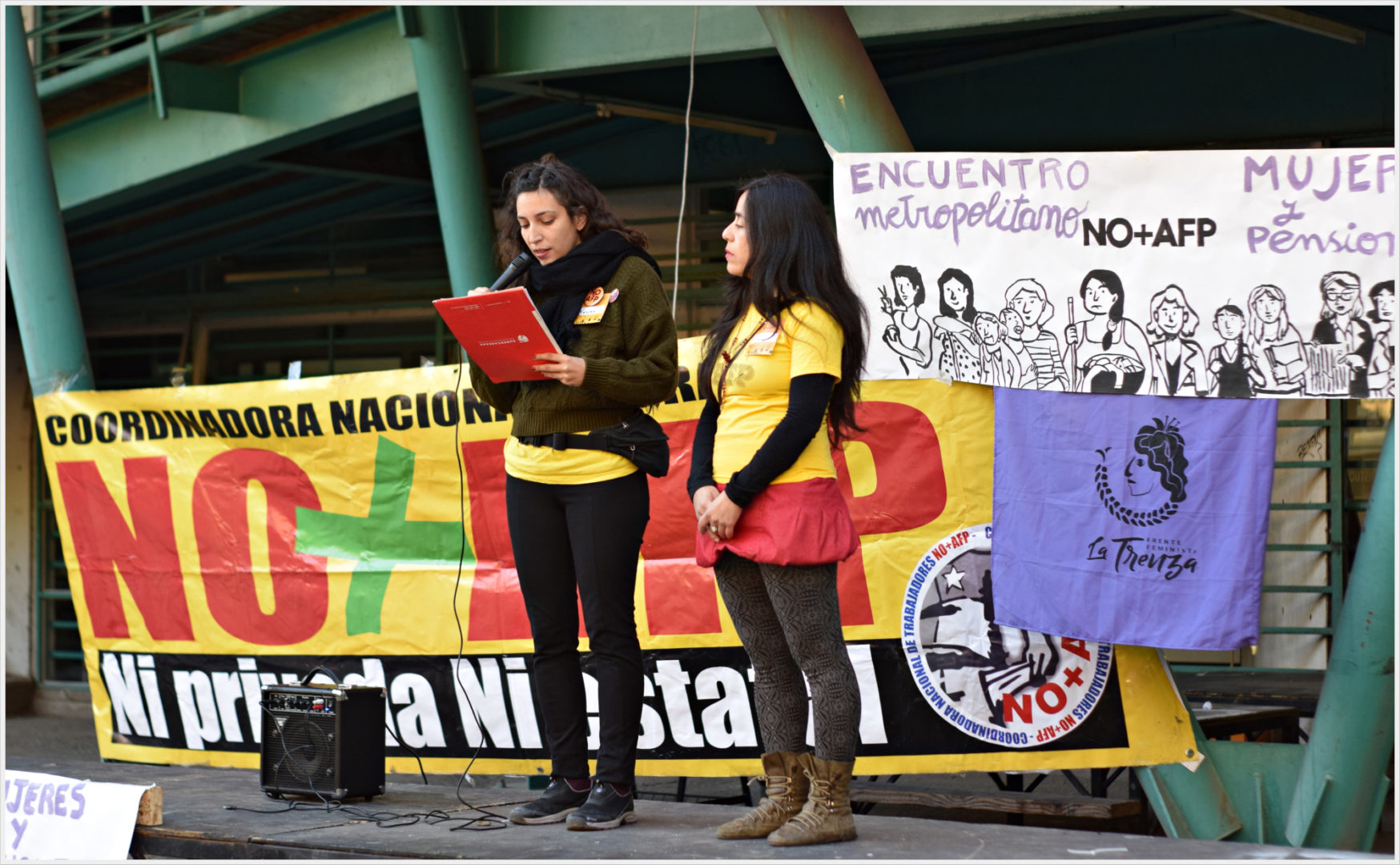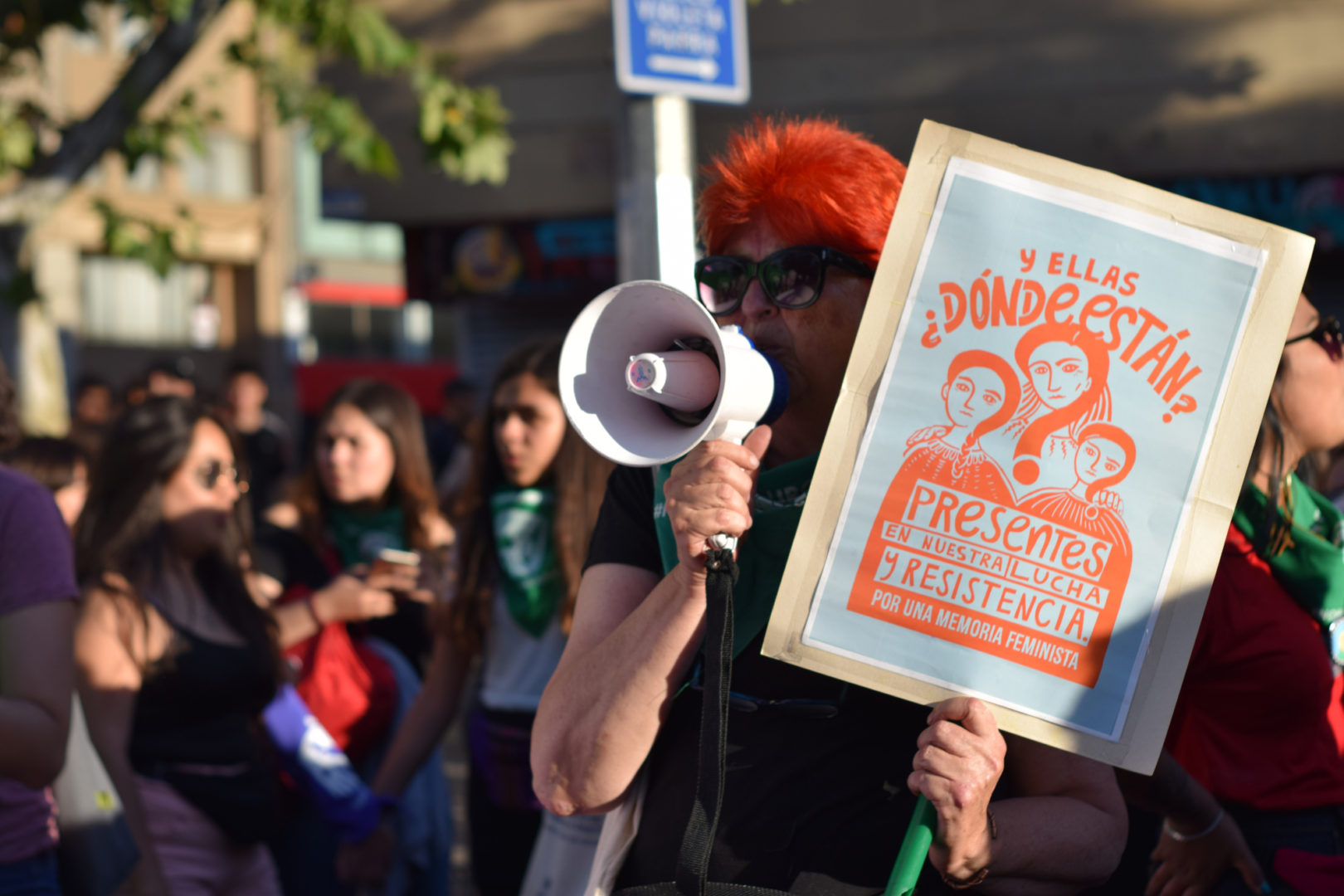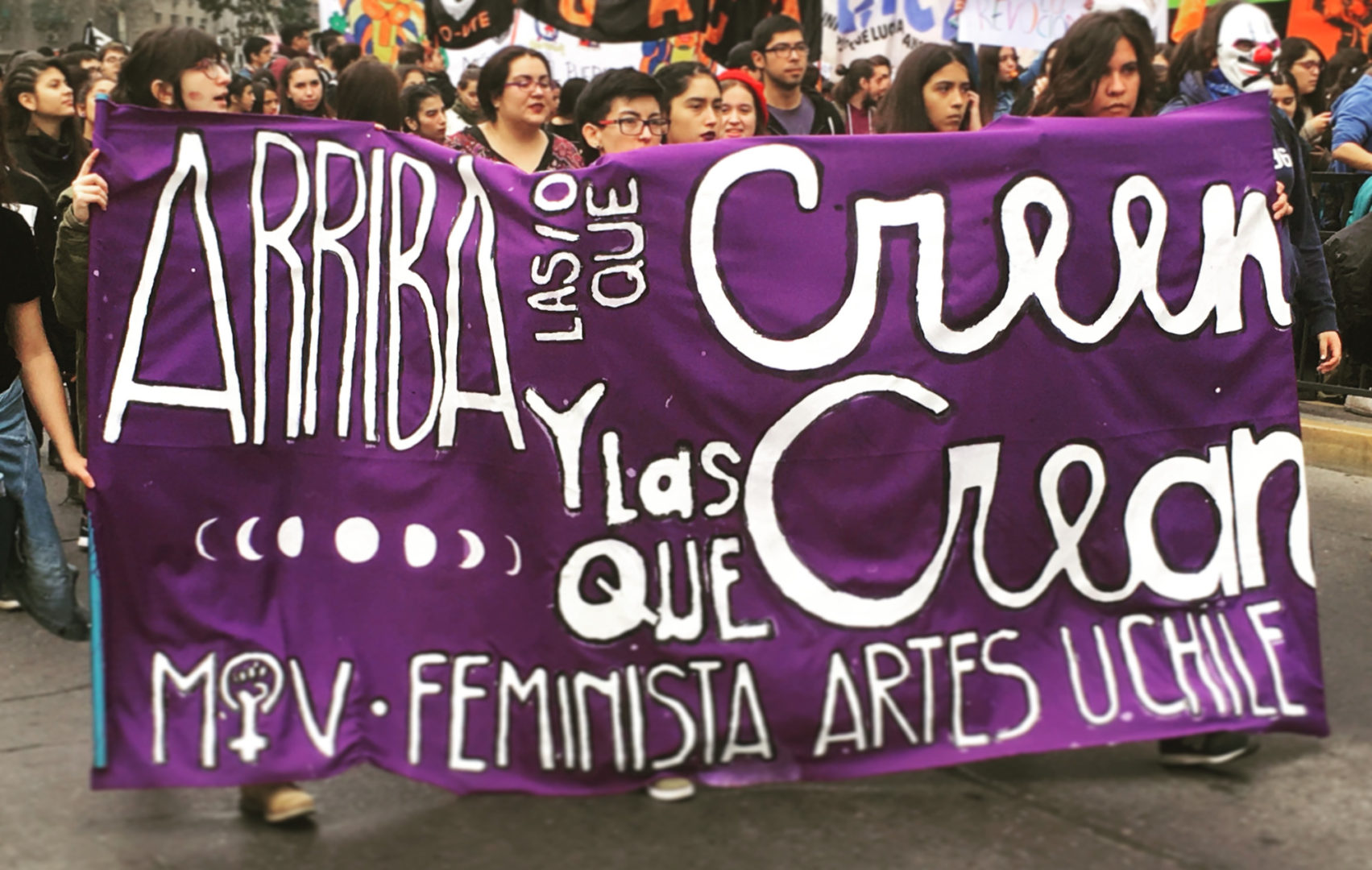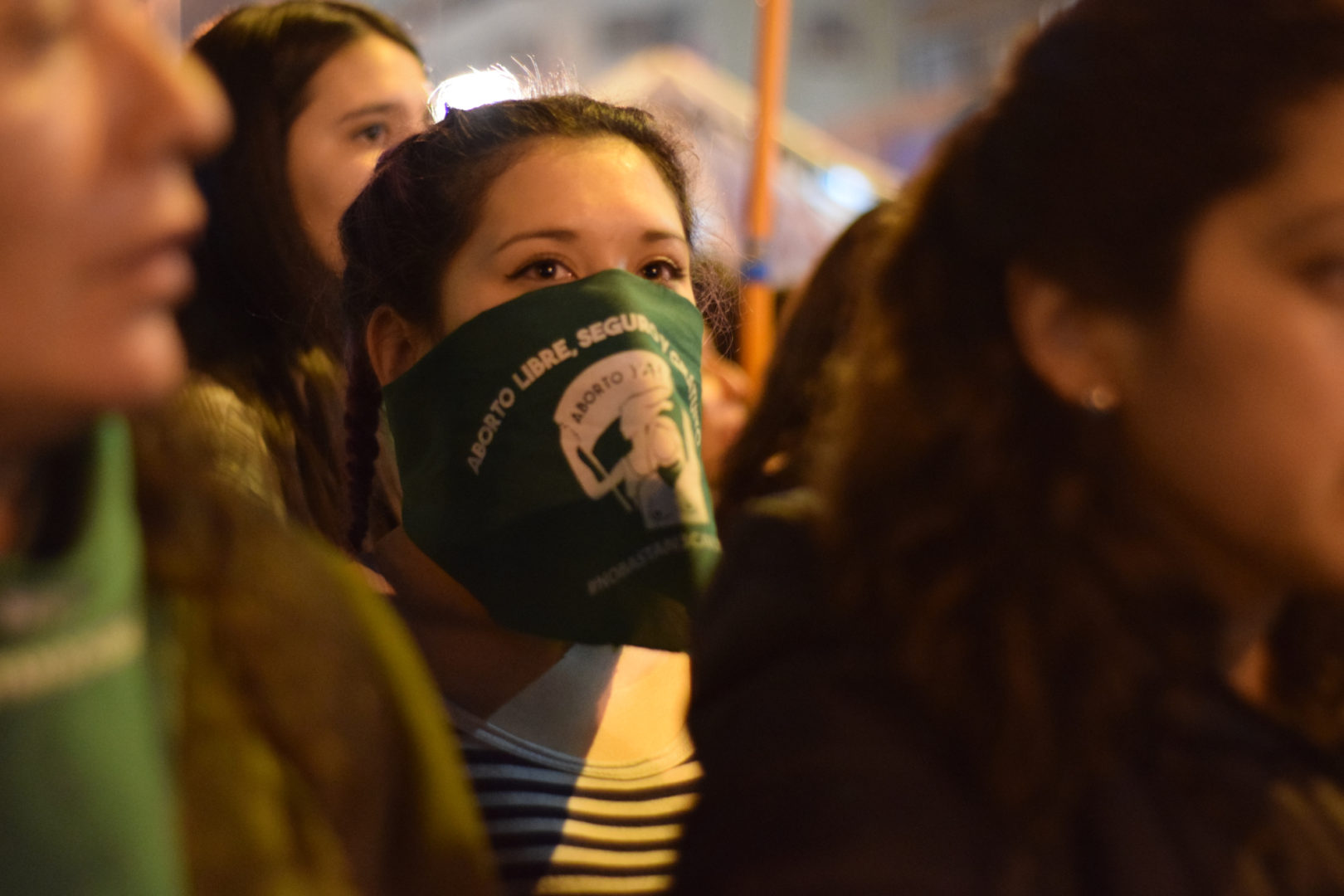Photo: Moreen Ramos
Chile’s feminist movement is here to stay
- March 8, 2019
Gender & Governmentality
Over the course of 2018, Chilean feminists established their movement through student resistance and the transnational fight for legal abortion.
- Author
The student feminist wave of 2018 struck so suddenly and spread so quickly that its impact resonated far beyond national borders. In Chile, feminism forced its way into the public consciousness, changing the course of the country’s many social movements as well as government policy. Like the student movement that rocked the country seven years earlier, this was accomplished through a series of groundbreaking events instigated by university and high school students, as well as some of the largest feminist mobilizations ever to take place in Chile.
The first article in this series described how the current Chilean feminist movement held the potential to revitalize Chile’s diverse social struggles through transversal, multisectoral politics. This strategy was exemplified by the Coordinadora 8 de Marzo (C8M), the feminist coalition rallying under the slogan, “Against the Precaritization of Life!” in answer to the suffering generated by the neoliberal project in Chile and the pervasive threat of patriarchal violence.
C8M emerged from a movement rife with ideological conflict and harried by external threats. After coordinating a massive mobilization on International Working Women’s Day 2018, organizers might have easily disbanded or collapsed under the pressure of internal divisions. However, they were thrust into the driver’s seat of the movement when outrage peaked in the universities, eventually sparking feminist activity throughout the country. This series of events came to be called the Mayo Feminista (Feminist May) and marked C8M’s rise to prominence as the most representative body of the expanding movement.
As 2018 wore on, the wave of university occupations began to wane as students returned to their classrooms. However, the energy of Argentina’s feminists who were making historic progress in their struggle for abortion rights jolted the movement back to life. By July, Chilean feminists had donned their own green bandanas in imitation of their compañeras across the border. Consequently, Chile’s growing fascist movement launched its first counterattack. Meanwhile, the shifting political landscape compelled both grassroots and government forces to adapt to the new reality opened up by the student feminist wave.
Mayo Feminista
The feminist wave was carried forward by a surge of collective frustration with inadequate university leadership in the handling of sexual harassment complaints. While some student bodies had successfully pressured their universities to implement a protocol to resolve cases of abuse, the slow pace of bureaucracy and lack of will on the part of the administrations often led to disappointing results. Other institutions had no protocols whatsoever.
Where the student movement had a foothold, this issue was woven into more established demands, such as the need for non-sexist education, institutional acceptance of queer and transgender students and an educational experience free of sexual harassment and discrimination. Student feminists drew strength and direction from these common demands, but also organized at the level of their own departments to define their own political priorities and determine appropriate tactics.
In Chile, high schools and universities have been self-organized for decades, tracing back to the period before the dictatorship. They draw on their popular memory of struggle, using strikes, school occupations and popular assemblies to exercise their power. Older students mentor younger students, passing on historical lessons and ensuring continuity within their movements. Feminist demands have been integrated into the student program for some time, but the eruption of feminist strikes in 2018 demonstrated that change was not happening quickly enough.
The first feminist occupation or toma took place in April 2018 at the Universidad Austral, located in the south of Chile. It was carried out in reaction to a disciplinary case of a professor accused of sexual harassment. It was almost immediately followed by a second, more prominent toma at the law school of the Universidad de Chile (UCh). UCh, centrally located in Santiago, is one of the most prestigious universities in the country and is known as a hotbed of leftist political activity. The feminist occupation — the first of its kind at UCh — promptly transformed the school into an informal headquarters for the growing movement. In a matter of weeks, over a dozen university departments were occupied or otherwise paralyzed by strikes.
School occupations interrupt “business as usual” and serve as a check on institutional power; they can force school administrations to find faster or more satisfying answers to student concerns. Furthermore, occupied spaces become centers of self-managed educational, cultural and political development. Run by popular assemblies, tomas give students the opportunity to participate in direct democracy. In intense periods of struggle such as 2006 and 2011, school occupations were so common that they became a cultural touchstone for a whole generation. But the feminist strikes gave new dimension to these traditional tactics.
On May 11, the public was shocked when a group of 127 female students from the law school of Pontificia Universidad Católica (PUC) delivered a public letter condemning the sexist environment they studied in, including a list of misogynistic comments they heard in classrooms. The shock, however, came not from the content of this letter, but from its place of origin: PUC is a conservative, religious institution far more likely to be associated with gremialismo (a far-right ideology championed by Pinochet-advisor Jaime Guzmán) than feminism. Even at the height of student resistance in 2011, PUC had only experienced a single toma.
Everything changed on May 25, when a group of students occupied La Casa Central (the main building of PUC’s downtown campus). This historic toma was controversial, as the occupiers clashed with other students whose positions ranged from liberal feminism to outright fascism. These ideological conflicts largely played out in the media, but on the first night of the toma, students reported a brief confrontation between the occupiers and gremialistas. Both the unexpected nature of the feminist takeover at PUC and the subsequent right-wing backlash foreshadowed larger trends as the feminist wave continued to advance through the country.
High school students join the struggle
There are several factors which distinguished the 2018 feminist wave from previous eras of student resistance, the most significant being that many of the popular assemblies voted in favor of “separatist” occupations, meaning that only women and sexual dissidents were welcome. Even in spaces where men were tolerated, their leadership was not. This was challenging for many male students who were not used to being excluded. This tension was especially visible in the liceos emblematicos, the country’s most prestigious public schools whose mixed class character has produced a long tradition of leftist student resistance. The feminist wave forced the conversation on intra-movement sexism, threatening a separatist rupture if male students could not adapt to the new political reality.
In a landmark event, at 12:15pm on May 15, 2018, 200 students from the all-girls school Carmela Carvajal de Prat invaded and occupied the all-boys school Instituto Nacional. A few hours later, they were joined by a contingent of 60 students from Javiera Carrera (another all-girls school) who initiated a solidarity protest outside. The feminist toma was initiated in response to the complaint of a Haitian janitor who reported being groped by a male student a few days earlier.
Tensions had already reached their breaking-point after the circulation of a mock rape video featuring Instituto Nacional students and an image of a sexist school jacket. The students of Carmela Carvajal insisted that the principal, Fernando Soto, resign, and endorsed a petition introduced by a group of Instituto Nacional students that called for an official protocol to handle cases of sexual harassment or assault. They also insisted that the school become gender-mixed. Both demands reflected the broader program for non-sexist education.
Nearly a dozen high schools throughout the country participated in some aspect of the feminist strike, including a variety of solidarity actions carried out by male students. Separatist tensions remained, but it did not take long for feminism to become such a dominant force that male students felt obligated to get on board or risk being left behind. This robust participation was reflected in the size of the marches that occurred throughout May and into June.
United under the banners of non-sexist education and an end to patriarchal violence, Santiago-based high school and university students mobilized on May 16 in the largest feminist mobilization in Chilean history. Initiated by the Chilean Student Federation (CONFECH), this march caught the world’s eye with its flashy contingents of young women marching topless while wearing maroon balaclavas — a choice that was as much a demonstration of power as a celebration of bodily autonomy.
C8M Popular Assembly
In 2011, the fight for free education opened the door to wider critiques of how neoliberal policies of privatization impact working people. In this way, the student movement was able to reinvigorate political debate and activity on the left. In the Mayo Feminista, the students once again dominated the popular narrative. However, the movement was only just re-activating and lacked the strategy and infrastructure necessary to unite feminists beyond the realm of education. This task would fall to the Coordinadora 8 de Marzo, the only broad feminist coalition still active when the university strikes began.

The first “Women and Pensions Conference” initiated during the Mayo Feminista by the No+AFP Coordinator. Photo by Moreen Ramos
Five weeks earlier, C8M successfully brought together feminists representing Chile’s diverse social movements to march on International Working Women’s Day. Now, it faced the challenge of doing the same — not for a day, but indefinitely. This work was enabled by the fact that the coalition already included many of the most active student feminists as well as members representing other social organizations such as the Coordinadora No+AFP.
However, the feminist movement was still largely defined by student activity and action had to be taken to transversalize it; to generate a collective identity across the diverse positionalities of its members. C8M determined that the first step towards this goal was calling for a popular assembly and actively soliciting the participation of women and sexual dissidents outside the educational sector.
The assembly was held on May 19 at the occupied UCh law school. Over 100 feminists attended, with male students handling registration, security and childcare. Facilitation was provided by members of C8M whose job was not to determine the discussion, but to articulate and advance it through a series of guiding questions.
One of the assembly’s priorities was to discuss mobilizing for a general strike on March 8, 2019. This theme evoked both excitement and controversy, since it was clear that many participants were wary of a feminist movement anchored in the elite universities of the capital. One attendee passionately argued that not all feminists could occupy their school or go on strike for even one day.
A C8M member responded that the seeds of a transversal movement had already been planted and that perfection should not be the enemy of the good. To build a general strike that was truly representative of the complex realities experienced by Chilean, migrant, and Indigenous women, she argued, the movement had to develop political common ground and advance multisectoral demands that leave no one behind. The general strike — like feminism itself — must be a tool to confront patriarchy on all fronts.
The assembly determined that the first test of this commitment would take place on June 1, with a call for a “Day of Feminist Action Against Precarity.” Instead of limiting themselves to a march through downtown Santiago, C8M encouraged decentralized actions reflecting the daily struggles of participants. This strategy arose from an understanding of how precarity itself was the primary condition impeding women’s participation in traditional methods of resistance. Informal workers had no unions, homemakers and caregivers received no wages and migrants risked legal consequences if they walked off the job. Therefore, the fight against precarity would also be a fight to create the conditions in which these marginalized workers could self-organize and build power.
Feminist Day of Action Against Precarity
The June 1 day of action was organized to coincide with President Piñera’s cuenta pública, the Chilean equivalent of a State of the Union address. With the feminist wave in full swing, Piñera was expected to push his Agenda Mujer, a series of policies designed to address gender inequity while avoiding the deeper systemic critiques posed by the feminist movement. His proposals made no mention of non-sexist education, safe and legal abortion, or ending patriarchal violence. What’s more, he offered no solutions for women working in the home or scraping by in the informal economy. In fact, it seemed as if the Agenda Mujer was designed exclusively for women already in the upper echelon of society.
When Piñera spoke before the Chilean Congress, C8M carried out of a cuenta pública of their own via Twitter. In a 10-minute video, spokespeople took turns describing the complex manifestations of patriarchal oppression in the lives of women in Chile, underscoring the need for a transversal feminist movement. As the day advanced, a wide variety of activities unfolded throughout the country, including neighborhood-level mobilizations, popular assemblies, artistic interventions, unpermitted marches, actions blocking traffic and cacerolazos (noise demonstrations). In the capital, several actions were met with police repression; most notably, police broke up a large downtown feminist gathering with water cannons and arrested over a dozen participants.
Despite its national impact, the day of action was not enough to sustain the initial momentum generated by the Mayo Feminista. Late July marked the beginning of a new semester and many student assemblies felt it was time to end their strikes and occupations. Some tomas had already been removed by police on the orders of the university administrations or had been taken down voluntarily after successfully bargaining for demands. The feminist wave was clearly receding and many were left wondering what would happen to the movement once the students returned to their classrooms.
The Green Sea
Beginning in 2015, feminist movements in Chile and Argentina were lifted by a rising tide of outrage against patriarchal violence. Whereas Chilean feminists went on to articulate their struggle as being “against the precaritization of life,” Argentinian feminists focused on the fight to legalize abortion. This was a natural extension of the NiUnaMenos movement, since Argentinian feminists saw the denial of safe, legal and accessible abortion as a form of state femicide. Historically, abortion was only legal when the pregnancy threatened the life of the mother or was the product of rape. That said, it was still incredibly difficult to obtain one, even when those conditions were met. The result was a high death rate from clandestine abortions.
In April, the Argentine Congress agreed to open discussion on possible changes to the law. Feminists rallied around this political opening, filling the streets and plazas of the capital and beyond with their mobilizations. Like the Mothers of the Plaza de Mayo who resisted the dictatorship while wearing white kerchiefs, the feminists fighting for legal abortion had popularized bright green bandanas as a symbol of their struggle.
The momentum peaked on June 14 when a bill legalizing abortion in the first 14 days of pregnancy passed the lower house. The celebratory crowd outside Congress numbered in the hundreds of thousands and with their green bandanas and face-paint, the feminists had transformed into a marea verde or “green sea” filling downtown Buenos Aires to the brim.
This victory flew across the Andes to inspire Chilean feminists with joy and hope. As recently as 2017, Chile had one of the most restrictive abortion laws in all of Latin America. This law was amended under the Bachelet administration to include the three standard exceptions: rape, fetal inviability and threat to the life of the mother. However, feminists continued the fight under the slogan #nobastan3causales or “three causes aren’t enough!” This new wave of enthusiasm was channeled into the annual march in favor of legalizing abortion which was just one month away.
The tradition of marching on July 25 began in 2013 with a march that ended in the occupation of one of Santiago’s most prestigious cathedrals, interrupting a special mass attended by the mayor and other government officials. Every year since, abortion rights activists have organized a march through the Coordinadora Feministas en Lucha (Feminists in Struggle Coordinator or CFL), a coalition composed of pro-abortion groups, now including C8M. CFL developed a Chilean version of the iconic green bandana featuring a logo combining a historical feminist suffrage graphic with an image of a topless student protester.
The 2018 march was massive, with almost 100,000 people mobilizing on the national level and 50,000 marching in Santiago. However, the resurgence of abortion as a topic of public debate provoked right-wing extremists who used the march as an opportunity to launch their first major anti-feminist attack.
The Movimiento Social Patriota (MSP, a third-positionist fascist organization) drenched the street with animal blood and attempted to disrupt the march route with burning barricades. In a different section of the march, a group of masked individuals stabbed several women as they passed by. The following day, MSP released a statement denying responsibility, but this was refuted by the victims and witnesses. As news of this incident spread, feminists saturated social media with inspirational photos from the march, declaring that this act of terrorism would not keep them from the streets.
Two weeks later, feminists had the opportunity to show the far-right that they had not been cowed by the recent acts of violence. The Argentine Senate was finally holding the decisive vote on the new abortion bill. In solidarity with feminists mobilizing throughout Latin America, C8M and allied feminist formations called for a protest to take place in front of the Argentinian Consulate in Santiago. The marea verde once again filled the streets, but they faced disappointing results. After 15 hours of debate, the Senate narrowly voted down the bill, 38 to 31. Despite this defeat, the feminists who had thrown themselves into the fight for safe and free abortion were undaunted. They had come closer to victory than ever before, and the struggle would continue.
Memories of Feminist Rebellion
September in Chile marks the return of warm weather and the week-long celebrations in honor of the national holidays. But September 11 is the anniversary of General Pinochet’s coup d’état that toppled the democratically elected government of Dr. Salvador Allende and installed a bloody dictatorship until 1989. For that reason, September is also a month for reflecting on the atrocities committed in that period and remembering those who were detained or disappeared.

A member of the Colectivo de Mujeres Sobrevivientes, Siempre Resistentes holds a sign reading “And where are they? Present in our struggle and resistance. For a feminist memory.” Photo by Moreen Ramos
It was in this spirit that C8M — now the Coordinadora Feminista 8 de Marzo or CF8M — collaborated with the Colectivo de Mujeres Sobrevivientes, Siempre Resistentes (Collective of Women Survivors, Always in Resistance or CMS-SR) to transform September into a celebration of the innovative and powerful history of feminist struggle in the face of repression.
On September 2, a group of feminist collectives carried out an intervention in front the former torture center known as “Venda Sexy.” Maintained from 1974 to 1975, Venda Sexy was the site where many political prisoners were held before being disappeared by Pinochet’s secret police. Among other crimes, it was infamous for the sexual violence inflicted on prisoners as part of their torture. The feminist organizers confronted this legacy directly, highlighting how rape and sexual humiliation were used to instill fear in women and keep them confined to their homes. Despite the dark history commemorated at this event, there was still a great deal of joy. The older feminists joined together with the younger under one empowering slogan: “We are not victims of violence, we are survivors!”
All month long, iconic methods of resistance were resurrected within a new context. On September 10, CF8M and CMS-SR hosted an olla comun or “common pot” in the plaza in front of the presidential palace. In order to survive food shortages under the dictatorship, people came together to share what they had — including subversive ideas. In this modern incarnation, organizers invited participants to recognize the revolutionary heritage present in the simple act of feeding friends and neighbors.
September marked other important dates that featured heavy feminist participation but were not part of the series of activities associated with the month of “Memories of Feminist Rebellion.” On September 30, immigrant and human rights organizations initiated a March Against Racism with the intention of raising consciousness around the inhumane treatment endured by migrants, particularly those from Haiti. This event commemorated the death of Joane Florvil, a Haitian migrant who died after being detained by police for the alleged abandonment of her infant daughter.
Joane was mourned by her partner and friends, but the publicity surrounding her death had already transformed her into a symbol for the struggle against state violence. CF8M was the only explicitly feminist formation involved in organizing the march; the group’s participation was motivated by an intersectional analysis of how xenophobia, anti-Black racism, and misogyny manifest in both government policies and individual acts of discrimination. They acknowledged that it was not their place to lead, but to stand in solidarity with all migrants.
Throughout 2018, CF8M was able to anticipate the ebb and flow of the movement and position themselves accordingly. The fruit of this labor was evident in September, as the feminists who survived the dictatorship joined hands with the students fresh from their university occupations. Furthermore, green bandanas had come to represent far more than the fight for legal abortion.
The movement was slowly growing transversal and, correspondingly, growing more influential. In the lead-up to March 8, it was time to flex this newfound power under a fresh slogan, one that would soon be on the lips of feminists in every part of Chile: La huelga general feminista ¡va! The feminist general strike is coming!
Source URL — https://roarmag.org/essays/chiles-feminist-movement-stay/
Further reading
Europe’s fight against the far-right
- Patrick Strickland, Shane Burley
- March 9, 2019
We need to live differently
- Simon Pirani
- February 28, 2019



